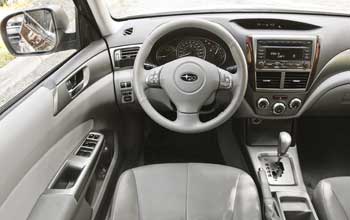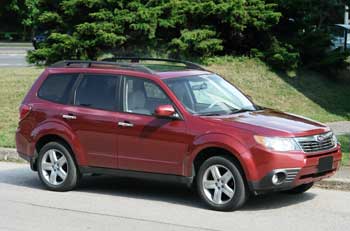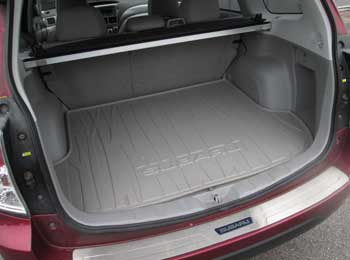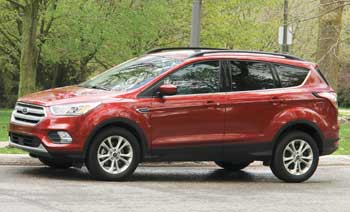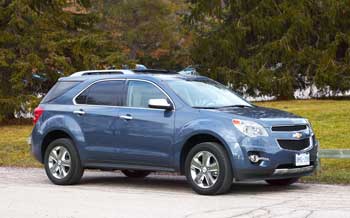Subaru Forester 2009-2013 pros and cons, common problems
By Vlad Samarin. Updated: January 27, 2024.
The Subaru Forester is a tall compact SUV with standard all-wheel drive. Thanks to its upright shape, the Forester offers a spacious interior and good front and side visibility. It's powered by a flat-4 "Boxer" 2.5-liter engine mated to a 5-speed manual or 4-speed automatic transmission..The Forester's low center of gravity provides a good balance between nimble handling and comfortable ride. With its tight turning circle (34.4 ft), it is also easy to navigate around tight corners. Let's start with pros and cons.
Pros:
- Practical Design: The Subaru Forester features a practical and versatile design, providing ample interior space, a good view of the road, and a functional layout.
- All-Wheel Drive: Standard Subaru's symmetrical all-wheel drive makes the Forester a good fit for snowy roads and inclement weather.
- Ground Clearance: The Forester's higher ground clearance makes it well-suited for outdoor adventures and some off-roading.
- Driving Experience: Thanks to its flat-4 engine, the Forester has a low center of gravity that contributes to good handling and a comfortable ride.
Cons:
- Interior Quality: While functional, the Forester's interior materials and design is less refined compared to some competitors in its class.
- Engine Reliability: The Forester will need engine repairs in its lifetime. Some will be minor, but others could be expensive. This means that it will be more costly to keep on the road at higher mileage.
- Fuel Efficiency: The Forester's fuel efficiency is lower compared to some other compact SUVs.
- Resale Value: The Forester will lose its resale value quicker than some rivals.
A number of Forester owners have reported the catalytic converter failing at higher mileage. The symptom is the Check Engine light with the code P0420 or P0421. When out of warranty, the repair is expensive. The OEM converter may cost over $1,000 to replace. Check with a local muffler shop for cheaper repair options with aftermarket parts.
The Check Engine light with the code P0171 could be caused by a failed A/F ratio sensor (oxygen sensor) or a bad mass airflow sensor.
A number of owners reported leaking head gaskets at high mileage; the repair is expensive, potentially over $2,000. One of the possible signs of a leaking head gasket is a coolant smell from the engine compartment and the dropping coolant level.
With the introduction of a new non-turbo engine (FB25) in the 2011 Forester, there have been complaints about oil consumption in this motor. Read this forum for more info. Google 'Engine Oil Consumption Subaru bulletin 02-157-14R'. Subaru did repair some of the engines under warranty.
Various oil leaks from the engine are common. The repair depends on the source of the leak.
Failed sway bar links and bushings are often mentioned. This repair is not very expensive.
Brakes need to be serviced regularly in order to prevent sticking and premature wear.
A/C problems are mentioned frequently.
Many owners mention various trim rattles inside the car.
Advertisement
Timing belt or Timing chain? The 2009 and 2010 non-turbo Forester come with an old-style EJ253 SOHC engine. It has a timing belt that needs to be replaced every 105,000 miles. For 2011 model, the non-turbo Forester models received a newer FB25B 2.5L DOHC engine that has timing chains instead of a belt. The 2009-2013 Forester with a turbocharged EJ255 DOHC engine has a timing belt that also needs to be replaced at 105,000 miles.
Summary
The 2009-2013 Forester is a comfortable, functional car to drive, and the Subaru AWD system is one of the best on the market. When considering a used Subaru Forester, the condition of the engine is a key. We recommend looking for non-turbo models, as the turbo motor is thirsty, requires premium gasoline, and is sensitive to a lack of maintenance.Consider an extended warranty for the powertrain with no limit per claim that will cover expensive engine repairs. Consumer Reports rates the engine's reliability 'worse than average' for all model years of this generation.
Given the oil consumption issues in the 2011-plus FB25 engine (non-turbo models), it's important to regularly check the oil level and top up if needed. Among competitors, we would recommend the Toyota RAV4 and Honda CR-V; both are rated well for reliability. The 2013-plus Mazda CX-5 is better on gas and should also be considered.
Related reviews:
Subaru Forester 2003-2008
Subaru Outback 2010-2014
Subaru Outback 2005-2009
Toyota RAV4 2006-2012
Toyota RAV4 2013-2018
Honda CR-V 2007-2011
Honda CR-V 2012-2016
Mazda CX-5 2013-2016
Fuel Economy: The 2013 2.5L non-turbo automatic Forester is rated at 21/26 mpg, which translates to 422 miles (679 km) to a tank with mostly highway driving. A turbocharged engine is thirsty and requires premium gasoline. Read also: Pros and cons of turbo engines.
How good is the Subaru Forester in snow? We didn't have a chance to test drive this Forester in winter, but we did test the previous 2008 Forester in foot deep snow. The car handled it with ease. Given that the 2009-2013 Forester is not much different, we expect it to be as competent is winter. Here is a great YouTube video showing how the Forester can handle the snow. The ground clearance is listed at 8.7 inches for 2.5X models and 8.9 inches for the 2.5XT (turbo) model.
What to look for when buying a used Subaru Forester: If you are buying from a Subaru dealer, checking the service history may reveal many potential problems, such as oil consumption. The low oil level could also be an indication of excessive oil consumption. Check if the A/C works. When started cold watch out for loud engine noises; avoid the car if the engine is noisy when started. During a test drive, watch out for jerking or rough shifting of the automatic transmission. A burnt oil smell under the hood may indicate oil leaks. The Check Engine light staying on must be investigated before buying a car, as some problems will be expensive to repair. We recommend having a used Subaru Forester inspected before buying by an independent mechanic familiar with Subaru products or another Subaru dealer. The engine needs to be checked thoroughly for leaks and other issues.
Towing capacity: For the 2012 Subaru Forester, the towing capacity is listed at "up to 2,400 lb. (200-lb. tongue weight)" on a trailer equipped with trailer brakes. You can find more detailed information in your owner's manual under section 8 "Driving Tips".
Resources:
Subaru Technical Information System - you can buy a temporary subscription and get access to a factory service manual and technical service bulletins. It's a great help for DIY enthusiasts.
Subaru of America Vehicle Resources - Access owner's manuals online, Starlink FAQ, BlueConnect guides and more.
NHTSA - check for recalls, safety ratings and search the complaint database.
Maintenance: According to the 2009-2010 Maintenance schedule, the engine oil needs to be changed every 7,500 miles for non-turbo models and every 3,750 miles for turbo models. A turbocharged engine is very sensitive to oil quality. Longer intervals between oil changes can lead to problems. If you notice the engine consumes oil between oil changes, check the oil level more frequently and top up as needed. Running the engine low on oil will cause problems. Read here: how to check the oil level. Spark plugs need to be changed every 30,000 miles for non-turbo models and every 60,000 for turbo models. The drive belt and timing belt need to be replaced every 105,000 miles. For 2011, the Forester has received a new 2.5L non-turbo DOHC engine. It doesn't have a timing belt, but the spark plugs need to be replaced every 60,000 miles.
Engine oil capacity:
When replacing engine oil and oil filter:
2009, 2010 Forester 2.5 L non-turbo: 4.4 US qt. or 4.2 liters
2011-2013 Forester 2.5 L non-turbo DOHC: 5.5 US qt. or 5.2 liters
2009-2013 Forester 2.5 L Turbo: 4.4 US qt. or 4.2 liters.
